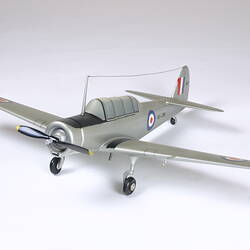As production of CAC Wirraway aircraft began in 1938-39, Lawrence Wackett, Manager and Designer at the Commonwealth Aircraft Corporation in Port Melbourne produced a new design for a primary trainer known as the CA-2 following a 1938 Air Board request. This small machine was designed to provide basic monoplane instruction to service pilots before they flew the more advanced CAC Wirraway. The De Havilland Moth Minor design was also considered for this role. The CA-2 cockpit instrument layout was very similar to the Wirraway and even had an undercarriage retraction control although the undercarriage was fixed. The CA-2 featured a metal tube fuselage like the Wirraway but had an all-wood wing and tail. The engine was intended to be a 130 horsepower Gipsy Major, later changed to a 200 horsepower six-cylinder De Havilland Gipsy Six.
Two prototypes were flown in 1939-40 using Gipsy Six engines removed from Tugan Gannet aircraft held by CAC. Now designated the CA-6 Wackett Trainer the aircraft was ordered into production in 1940 but supply of the Gipsy Six engine could not be secured from Britain. The American Warner Super-Scarab radial engine of just 165 horsepower was substituted. Delays with development and priority given to Wirraway production meant Wackett Trainer production did not begin until early 1941 and concluded in 1942 after 200 were made. Wings and tail assemblies were built by General Motors-Holden at Fishermens Bend.
The Wackett was mostly used by the RAAF at the Wireless Air Gunner Schools (WAGS) at Ballarat, Victoria and Maryborough, Queensland. Some service pilots disliked them intensely due to their lack of power. RAAF pilot and author Geoffrey Dutton referred to the Wackett as "a horrid little aircraft" in his autobiography Out in the Open. The surviving Wackett Trainers were quickly retired by the RAAF after the end of the war in 1945 with many being acquired by J.T. Brown & Co. About 45 were sold to the Netherlands East Indies postwar. Most aircraft were flown by private owners and some were converted to KS.2 crop dusters by Kingsford Smith Aviation Service Pty Ltd. A highly modified crop spraying version with metal wings and a 250 horsepower Continental engine was put into limited production as the Yeoman YA-1 Cropmaster between 1964 and 1966. Six Cropmasters were exported to New Zealand.
More Information
-
Keywords
-
Localities
-
Authors
-
Article types






